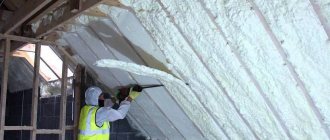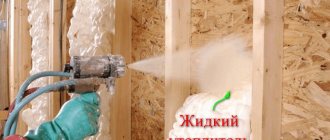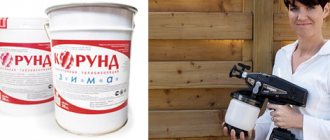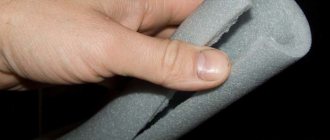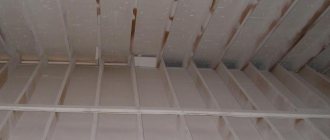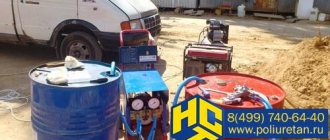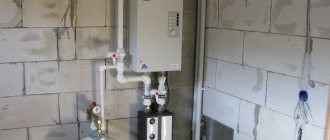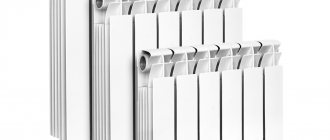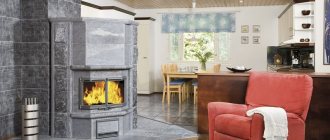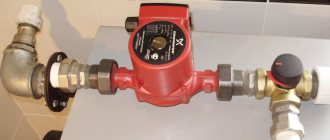In one of the articles, we helped you understand the types of bulk insulation. Today we will talk about a composite with high thermal insulation properties, called liquid thermal insulation “Corundum”. Without exaggeration, it is the first domestic product created in our country using national technologies using high-quality imported raw materials. This is the best material in its niche in terms of the ratio of the quality of the result and the cost of the material.
Description and features of Corundum production
Liquid heat insulator Corundum is a mixture of acrylic binder and ceramic microspheres with thin walls that contain rarefied air. Acrylic binder is made using fixatives and catalysts.
Microspheres have a size in the range of 0.01-0.5 millimeters. Also, various additives are additionally introduced into the product, which are designed to enhance its certain qualities. This balanced composition gives the material lightness, elasticity, flexibility and stretchability. In addition, Corundum has excellent adhesive ability.
The consistency of liquid ceramic heat insulator is similar to ordinary paint. Essentially, it is a white suspension, which, after polymerization, forms an elastic and durable polymer coating.
Unlike conventional thermal insulation materials, Corundum not only protects a building or any other structure well from heat loss, but also prevents metal surfaces from rusting.
Initially, such ceramic heat-protective coatings were created by order of NASA for use on spacecraft. After some time, it was possible to adapt these compositions to “earthly” needs. Corundum is the trade name of a product developed by Russian scientists. This heat insulator has all the necessary certificates confirming its quality.
Advantages and disadvantages
Liquid thermal insulation Corundum is a modern high-tech material. If we talk about its advantages, it is worth noting the following:
- versatility. Thermal insulation with Corundum can be carried out on almost any substrate. The material has high adhesion and perfectly covers the entire surface;
- durability. Corundum perfectly retains its characteristics for 15 years. And if you take proper care of it (clean it and perform a high-quality finishing), then its service life can almost double;
- liquid heat insulator Corundum will not only insulate the structure, but also protect all elements from corrosion;
- the material perfectly withstands exposure to aggressive environments and direct ultraviolet rays;
- liquid thermal insulation material Corundum is easy to apply to any surface. It has all the qualities of regular paint, so there will be no problems with installation. In addition, the repair of the thermal insulation layer is greatly facilitated. It is enough to remove the old material and apply new one;
- liquid heat insulator is resistant to fire. Even when heated to 260 degrees, the material will only char. And if the temperature rises to 600 degrees, then Corundum will begin to decompose into nitrogen oxide and carbon.
But this material also has its disadvantages. Thus, these include the high cost of the heat insulator Corundum. In addition, the material is new, so all its declared characteristics have not yet received their practical confirmation.
Possible applications
The technical characteristics of the new ultra-thin insulation make it possible to use it in many areas of the national economy. The composite is most widely used in construction, industry and transport. Corundum copes well with insulating external and internal walls of buildings and structures, regardless of architectural features and general surface curvature.
It is also used for thermal insulation of roofs, attics, balconies, window slopes, concrete floors and ceilings. The thermal insulation effect from a barrier thickness of 1 mm is equivalent to the effect obtained from brickwork 1.5 bricks thick
An important feature is that the coating does not create additional load on the main structural elements
Anti-corrosion
The benefits of using insulation in industry are not limited to reducing heat loss. It successfully solves the problems of equipment corrosion protection. Thermal coating Corundum is applied to pipelines for steam, hot water and circulating water supply, as well as their piping fittings. Used to protect air conditioning and ventilation systems, as well as some capacitive equipment under suitable operating conditions. Prevents temperature deformation of metal structures.
Thermal insulation is applied to containers and tanks on railway and wheeled transport, as well as trailers, containers and refrigerators. In shipbuilding, engine rooms and holds are treated with Corundum material.
Application area
Ultra-thin ceramic insulation Corundum is an innovative material that forms a durable elastic coating that reliably protects the surface from moisture, overheating and corrosion. This composition is used in the temperature range from -65°C to +260°C.
The main areas of application of thermal paint include:
- housing and communal services facilities (including treatment of pipelines for various purposes, thermal insulation of facades, roofs, windows, walls);
- transport industry;
- oil industry;
- insulation of thermal power structures;
- construction industry.
For information
Liquid thermal insulation Corundum is a mixture based on an acrylic binder and ceramic microspheres, which have thin walls and contain rarefied air inside. Acrylic-type binders are created using substances from the group of catalysts and fixatives.
Microspheres have sizes up to 0.5 mm. In addition, it contains various additives, so if Corundum is chosen, the facade will be processed very efficiently, since such additives enhance certain qualities of the product. The composition is completely balanced, so the material is elastic, light and stretchable. In addition, the Corundum coating has good adhesion.
The consistency of the substance resembles simple paint. This is a whitish suspension. The material not only has thermal insulation properties, but is also able to protect metal parts from corrosion.
In addition, Corundum is a thermal insulation that has many other advantages:
- Keeps warm well. It has been established that 1 mm of such paint is comparable in its ability to conserve heat with 5 cm of roll-type insulation (for example, mineral wool). The reviews are very good.
- It is easy to apply the substance to surfaces. The paint must be applied using conventional tools. You can use a spray gun, roller, or brush. The product does not emit harmful compounds, so respiratory protection is not required.
- If Corundum is chosen, the facade will be protected from various damages due to the influence of aggressive environmental factors. For example, metal will not rust. Wood does not dry out or rot. The brick, concrete layer and plaster do not crumble and cracks do not appear on them.
- If Corundum is applied, the facade will not be destroyed due to the influence of rodents, insects, bacteria and other pests. The surface does not rot. Mold does not form either.
- The insulating layer is lightweight. If Corundum is chosen, the facade will not have additional load, as if other insulation materials were used, for which it is necessary to install additional special retaining structures. Due to the light weight of the layer, Corundum can be applied even to fragile surfaces.
- There are no seams. Thanks to this, there will be no cold spots. The thermal insulation layer will be seamless, so the cold will definitely not be able to penetrate into the room.
- Durability. It is enough to apply the product only once, and you will not need to replace such a layer for a long time.
- The use of the material is also associated with its environmental friendliness. Over a long period of operation, such a layer does not emit harmful components. The product can even be used in homes where people who are prone to allergies live.
- Neither the area of the room nor its geometry is affected, which is taken into account when using bulky structures. Corundum will not affect the dimensions and shape of the building.
- Can be used as a finishing material. Special components from the group of pigments are added to this paint, so it is also used as a decorative coating.
But it must be taken into account that such a heat-insulating layer also has its drawbacks. First of all, this concerns the high cost. The material appeared on the construction products market not so long ago, so the price is still quite high. However, this drawback is offset by the fact that thermal paint retains heat well and the layer will last quite a long time. You also need to take into account that the material, as reviews indicate, hardens very quickly, so you will have to apply it quickly.
An example of an estimate for using corundum thermal insulation
Types of material
Liquid thermal insulation material Corundum is available in several versions . The manufacturer offers to purchase the following varieties:
- Classic - this product is widely used in roofing and facade work. This brand is also perfect for thermal insulation of interior spaces with any type of coating. Classic is a universal and highly effective thermal insulation product;
- Anticorrosive This material is primarily used for anti-corrosion coating of metal structures. In this case, the protective layer can be applied directly to areas with rust, without any pre-treatment;
- Facade - this type of thermal insulation material is specially designed for covering concrete, slag concrete and foam concrete walls and structures. It is applied in a thicker layer, which speeds up work and improves thermal insulation qualities. This variety is most often used for finishing the facades of houses;
- Winter. It is not always possible to complete all thermal insulation work in the warm season. If insulation is carried out at temperatures down to -10 degrees, then you need to use this particular type of thermal paint.
There are a number of other types of this liquid thermal insulation material, but they are used less frequently. But no matter what brand of Corundum you use, high thermal insulation properties of the coating are guaranteed.
Work technology
Sprayed insulation and thermal paint are applied to a clean, durable base without corrosion or areas of biological damage. Painting is carried out in the same way as with traditional compositions: priming, forming a layer-by-layer coating with intermediate drying of each. The manufacturer writes on the packaging about the intricacies of the work.
Insulation of walls using insulating foam occurs in the following order:
- installation of sheathing made of lumber, metal or plastic profiles;
- spraying a heat insulator onto the working surface across the entire width of the opening in the direction from bottom to top (it may be possible to repeat the procedure to increase the thickness of the coating);
- protection and decorative finishing of the formed layer.
The sheathing serves as a reinforcing material and a guide to the thickness of the insulation. After the foam has dried, the excess foam composition is cut off along the sheathing. This results in a smooth surface, which is easier to work with later at the finishing stage.
Foam insulationSource ytimg.com
Insulation or heat insulator
Being a complex multi-level structure that minimizes existing methods of heat transfer, the heat insulator is of increased interest: “Is corundum an insulation or a heat insulator?”
However, these concepts should be distinguished. The operating principle of insulation is based on the physical thermal conductivity of the material. Therefore, the effectiveness of insulation depends on the thickness of the insulation. The operating principle of a heat insulator, on the contrary, is based on wave physical properties. The thickness of corundum ultra-thin thermal insulation ranges from 1 to 6 mm. The shocking limits of the minimum thin thickness of the insulation layer are, perhaps, the main advantage of Corundum over existing thermal insulation materials.
Video description
Here is the testing of balloon sprayed insulation:
Briefly about the main thing
The group of liquid insulation materials includes thermal paints and polymer foaming compounds. This also includes moistened ecowool, as it is applied by spraying.
The main advantage of the materials: high energy efficiency of thin-layer coating. The main disadvantage is the total cost according to the estimate. More often, spraying is carried out using special equipment that is not purchased for home use. Therefore, we have to hire craftsmen. If you purchase the material in gun cylinders, you can do the work yourself. But here there is a large consumption of expensive foam.
The insulation technology consists of 3 stages: surface preparation, application of insulation, decorative finishing. The base must be clean, strong and “healthy”. A sheathing is installed under the sprayed compositions. The finish can be anything: painting, paneling, plastering, cladding. Less commonly, thermal insulation coating is used as an independent coating.
Disadvantages of ultra-thin thermal paint Corundum
Despite the impressive list of advantages of the material, it is not without some disadvantages. Among them, the following aspects should be highlighted:
- High cost of thermal paint.
- Since ceramic thermal insulation is a relatively new product on the construction market, there is no time-tested evidence that the material meets its declared characteristics.
Features of the material
Thermal insulation with Corundum has recently become very popular. This is a modern method using a special ceramic heat paint. Externally, this material is not much different from ordinary paint.
All the most important things are hidden inside
Liquid thermal insulation Corundum is made from a mixture of water-acrylic solution and ceramic fillers. The first component allows the material to evenly distribute heat-insulating elements over the entire surface. And hollow ceramic spheres of microscopic size act as a heat-insulating element.
Due to its composition, thermal insulation with Corundum is carried out quickly and evenly covers the entire area, going even into the most hidden areas.
Areas of application
What can Corundum thermal insulation be used for?
- For insulating walls, both inside and outside the building
- For insulation of facades
- For insulation of floors, including attics and roofing structures
- For thermal insulation of pipelines, both located indoors and those running through open areas.
- For insulating industrial non-insulated tanks, including tanks and refrigerators.
- Thermal insulation Corundum is used where it is not possible to use other types of insulation due to difficulty of access or operational features of the structure.
In conclusion, let us turn to the dry language of numbers, which will confirm the properties of liquid thermal insulation.
So, the thermal conductivity coefficient of thermal insulation Corundum is from 0.01 to 0.02 W. The material consumption is 1 liter per 1 square meter of area, the water absorption coefficient is 0.04 grams per 1 cubic centimeter of area (the indicator is calculated for material completely immersed in water for 24 hours).
The density in liquid form is from 450 to 550 kilograms per cubic meter. The material can withstand shock loads of 50 kg per square centimeter. The vapor permeability coefficient is low, it ranges from 0.02 mg/m h Pa. But the material does not allow water vapor to pass through and prevents increased humidity in the room.
So the use of Corundum thermal insulation is not only the use of the latest insulation technologies with maximum efficiency and ease of application. It also provides protection from moisture, rust, and other adverse and aggressive influences for a period of 15 to 20 years.
Technical characteristics of liquid ceramic thermal insulation Corundum
Thermal insulation material Corundum has technical characteristics that allow it to be used on structures of various configurations and purposes. With a minimum thickness, this product can provide a good level of insulation. Let's consider the main characteristics of Corundum thermal insulation:
- Thermal conductivity
. In numerical value, this indicator is equal to 0.0012 W/(m*C). This is significantly lower than many traditional thermal insulators such as polystyrene foam or mineral wool. - Moisture resistance
. The material does not allow moisture to pass through and is not destroyed under its influence. Even saline solutions have no effect on Corundum. - Vapor permeability
. Thermal paint does not create an airtight film on surfaces. It allows air exchange to occur, maintaining an optimal microclimate in the room. - Fire resistance
. The material does not support combustion. When the temperature reaches 800 degrees, Corundum begins to decompose, releasing carbon and nitrogen monoxide. And at a temperature of +260 degrees, the thermal insulation becomes charred. According to fire safety standards, the material belongs to classes G1 (non-flammable) and B1 (non-flammable). - Adhesion
. In terms of tear-off force, this indicator may vary depending on the type of surface on which Corundum is applied. So, for concrete this coefficient is 1.28 MPa, for steel - 1.2 MPa, for brick - 2.0 MPa. - Operating temperature range
. Corundum has a fairly large range and ranges from -60 to +260 degrees. - Ultraviolet resistance
. The material does not deteriorate under the influence of sunlight. Therefore, you can use it even without a protective coating. - Biological stability
. Mold, fungi, and rot do not form on surfaces treated with Corundum. Also, the material is not used as food by insects or rodents. - Environmental friendliness
. Liquid ceramic thermal insulation does not emit any toxic compounds into the atmosphere even when heated. You can also work with it without using special personal protective equipment. - Lifetime
. This is a durable coating that does not lose its quality for at least 10 years. It does not crack and does not collapse.
Insulation paint – paint and insulate
Insulation paint is multifunctional. It retains heat well, prevents water from penetrating into structures, and protects against the formation of mold. Corundum thermal insulation extends the service life of pipes, tanks, refrigeration equipment, and air conditioners. Retaining heat is the main purpose of thermal paint, so it is indispensable for thermal insulation of pipes. The materials currently used are short-lived and harmful to humans. Pipes coated with corundum thermal insulation withstand the effects of precipitation and sunlight.
According to sad statistics, a huge number of fires occur due to the fault or direct participation of heat-insulating materials. Often the walls are lined with flammable thermal insulation, and in the event of a fire, the fire with lightning speed, with the help of this insulation, spreads throughout the entire building, spreading to the roof and neighboring entrances. To prevent this from happening, use heat paint. This is an inexpensive material that is safe in all respects and does not support combustion.
Criterias of choice
When choosing thermal insulation paint, you need to take into account its characteristics and the types of intended work. Much depends on the object of application and its location, as well as the type of surface. It would be useful to study the most frequently offered manufacturers on the market and get acquainted with the opinions of buyers about their products.
For example, for work carried out outside, you need to pay special attention to water resistance and the ability of the mixture not to lose its properties in both cold and hot weather. For interior finishing work, paint that does not emit harmful substances is required.
For painting pipes, thermal materials with maximum heat resistance are used.
It is also necessary to calculate the most accurate amount of mixture that will be required for the job. First of all, it depends on the area on which you plan to apply thermal paint. The surface of the object plays an important role. Overruns when working with wood, concrete and brick can be up to 10 percent, and with metal products – up to 6 percent.
It is necessary to consider how thick the paint will be applied, as well as the number of layers. For different materials, manufacturers recommend using different layer thicknesses, for example, 1.5 millimeters of the mixture is enough for concrete, 2 millimeters for wood, but brick, metal, expanded clay concrete need to be covered with a layer of 2.5 millimeters.
Advantages and disadvantages of Corundum
The heat insulator is capable of completely filling the micropores of the surface being treated. In this case, the concentration of the polymerized material is 80%. In addition, coating thermal insulation Corundum has the following advantages:
- Excellent heat retention
. One millimeter of heat-saving paint is comparable in effectiveness to 50 millimeters of rolled insulation, for example, mineral wool. - Easy to apply
. Corundum is applied like regular paint using standard tools: brush, roller, spray gun. It does not emit harmful substances and therefore does not require respiratory protection. - Protects surfaces from destruction
. Metal coated with Corundum will not rust, wood will not rot and dry out under the influence of atmospheric conditions, plaster, brick, concrete will not crumble and become cracked. - Does not attract microorganisms, insects, rodents
. Surfaces covered with this insulation will not rot or mold. - Lightness of the insulating layer
. The weight of Corundum insulation is incomparable with traditional roll coating. Such thermal insulation will not place any load on the load-bearing walls and foundation. Therefore, liquid ceramic insulation can be applied even to unstable and fragile structures. - No seams or cold bridges
. Corundum allows you to create a durable, seamless coating through which the cold cannot penetrate into the room. - Environmental friendliness and durability
. Throughout its entire service life, the material does not emit any harmful substances. Therefore, it can be safely used to insulate residential buildings, as well as houses where allergy sufferers live. - Does not affect the geometry of the room
. Unlike bulky traditional thermal insulation, Corundum will not affect the size and shape of the building in any way. - Can serve as an independent finishing layer
. Pigments can be added to thermal paint, which allows it to be used for wall decoration without additional decorative coatings.
Basic properties of corundum thermal insulation
Thermal insulation corundum has a microporous structure that reflects about 85% of radiation. A significant reduction in heat loss occurs due to the low thermal conductivity coefficient. What other properties can this insulation boast?
- The temperature regime in which thermal insulation retains its effectiveness and properties is from -60 to +250 degrees Celsius.
- The manufacturer promises to preserve the properties of the material for 15 years.
- For greater safety, the Corundum heat insulator is also available in a frost-resistant modification. Storage of such material is allowed even at a temperature of -30 degrees. True, in such unfavorable conditions, thermal insulation can last no more than 1 month. Allow 5 cycles of freezing the material before using it.
Heat insulator Corundum is available in a whole range of modifications
- The Corundum Classic material is a universal heat insulator that is used to insulate the external and internal surfaces of residential, industrial, office buildings and structures, pipeline systems, as well as refrigerators, tanks and other industrial containers. The heat insulator is produced in plastic buckets, which can have a volume of 5,10 or 20 liters. Cost - from 300 rubles per liter. When purchasing in bulk, you can get a discount (approximately 10%).
- Insulator Corundum Facade is specially designed for thermal insulation of facades made of all kinds of materials. This insulation can be applied directly to the outer wall of a building with a layer thickness of 1 mm in one application. This modification has increased vapor permeability, which ensures natural ventilation of the building. Thermal insulation Corundum Facade has proven itself in eliminating fungi, mold, freezing of walls or structures. The material is produced in plastic buckets with a capacity of 5, 10 or 20 liters. Price - from 330 rubles per 1 liter, with wholesale purchases you can get an additional 5-15% discount.
- Thermal insulation Corund Anticor is unique in that it can be applied to a rusty surface. It is enough to remove the outer layer of rust, which is loose and easy to clean with a wire brush. After this, insulation can be applied. Corundum Anticor not only preserves the surface and has anti-corrosion resistance, it effectively prevents the spread of oxidation deeper and wider than the surface. This type of material is successfully used for insulating pipelines and metal structures, as well as as a base layer for the subsequent application of other products of the manufacturer, for example, Corundum Classic. The insulator is available in plastic buckets with a volume of 10 or 20 liters. The cost of 1 liter of Antikor is from 410 rubles. When purchasing in bulk, you can count on a discount of about 10%.
- Thermal insulation Corundum Winter is perfect for those cases when the work on thermal insulation of the facade occurs in the winter season. The coating is intended for objects requiring high-quality thermal insulation, including those susceptible to corrosion and prone to condensation. We remind you that most known thermal insulation materials can be worked at temperatures not lower than +5 degrees. Corundum Winter can even be stored at low temperatures (up to + 30). The insulation is supplied in a plastic bucket with a volume of 20 liters. 1 liter of liquid winter modification insulator costs from 420 rubles.
- A material under the working title Corundum Fire Protection is under development. It is intended to increase the fire resistance limit of residential and industrial buildings and structures. When exposed to high temperatures, the coating provides fire resistance of 1 hour with a dry layer thickness of 1.5 mm. The coating system consists of a primer, a fire retardant material and a finish coating with fire resistant properties.
- Thermal insulation Corundum can be used comprehensively, in a combination of several materials. For example, to insulate a metal surface, a layer 2.5 mm thick is required. In order to achieve this indicator as efficiently as possible, you can use the Corund Anticor modification for the primer, and then apply two layers of Corundum Facade. Thus, the required insulation thickness of 2.5 mm will be obtained, while an anti-corrosion, moisture-resistant and heat-insulating surface coating will be provided.
Thermal insulation corundum - prices and discounts for wholesale buyers
PRICE for 1 liter - 330 rubles. FOR WHOLESALERS % DISCOUNTS
With all its positive qualities, Corundum thermal insulation is also affordable. You can choose a convenient packaging and save on installation: the paint is applied with a spray or brush. Consumers who have used Corundum clearly distinguish this thermal paint from similar ones. Even without special equipment, but simply placing your hand on a wall covered with Corundum, you will feel the warmth, while an unpainted wall will cool your palm.
Corundum – the warmth of your home!
| "Classic" - for all surfaces | "Anticor" - for rusty surfaces | "Facade" - for external work |
Features of the material
Thermal insulation with Corundum has recently become very popular. This is a modern method using a special ceramic heat paint. Externally, this material is not much different from ordinary paint.
All the most important things are hidden inside
Liquid thermal insulation Corundum is made from a mixture of water-acrylic solution and ceramic fillers. The first component allows the material to evenly distribute heat-insulating elements over the entire surface. And hollow ceramic spheres of microscopic size act as a heat-insulating element.
Due to its composition, thermal insulation with Corundum is carried out quickly and evenly covers the entire area, going even into the most hidden areas.
Features of ceramic thermal paint
The unique composition of thermal insulation is also called heat-reflecting paint, since with a layer thickness of only 1 mm it can have a noticeable energy saving effect. Thanks to this, Corundum thermal insulation is very economical in consumption. The filler consists of microscopic hollow spheres - ceramic, polymer, composite, glass balls, which are filled with rarefied air. Such microparticles can vary not only in composition, but also in the size of microgranules, percentage, homogeneity of components, etc.
Externally, ceramic ultra-thin paint is practically no different from ordinary acrylic-based paint. Despite the fact that today the construction market offers several varieties of ultra-thin insulating compositions, almost all of them have a similar structure:
- The thermal paint is based on a water-acrylic solution. Its properties make it possible to ensure uniform distribution of thermal insulation components over the working surface. In addition, the composition promotes better fixation of liquid ceramics.
- The binder also contains various additives that improve the performance parameters of the thermal paint. The most common material additives include natural and artificial rubbers, silicone, etc.
Brief instructions for applying Corundum thermal insulation
To apply thermal paint you will need standard painter's tools - brushes, roller or spray gun. Using a sprayer you can get the best quality of application and low consumption of Corundum thermal insulation. The average thickness of one layer should be about 0.4 mm. Each subsequent layer should be applied only after the previous one has completely dried. When working with a roller or brush, the average material consumption is about 0.5 liters per square meter.
We apply Corundum thermal insulation following these instructions:
- Pour the paint into a large container and mix it thoroughly so that the mixture is completely homogeneous. To do this, you can use a drill with a special attachment. You need to set the speed to medium so as not to destroy the structure of the ceramic spheres.
- We clean and degrease the surfaces on which we plan to apply Corundum. If it is metal, then we clean off the top layer of rust. We use gasoline, kerosene or solvent as a degreaser.
- We begin to apply heat paint to completely dry surfaces. The first layer should be of minimum thickness, as it is considered a primer.
- If you use a spray gun or roller to apply Corundum, then joints and hard-to-reach places will in any case have to be treated with a brush.
- If you use Corundum brand “Winter”, then work can be carried out at a temperature not lower than -10 degrees. For other types of liquid thermal insulation, the optimal application temperature is +20 degrees.
- It is recommended to create no more than three layers of insulation to achieve optimal results.
- It usually takes about a day for all layers to dry completely. If hot pipes were painted, polymerization occurs much faster.
The heat insulator Corundum on surfaces looks aesthetically pleasing, and therefore can be used as a finishing material. If you are planning additional painting or plastering of surfaces, then this can be done over layers of thermal paint. Watch the video review of Corundum:
Corundum is the latest invention of Russian scientists in the field of thermal insulation. The material is widely used for insulation of buildings for various purposes, pipelines and other objects. This is an environmentally friendly and reliable ceramic liquid thermal insulation.
In the construction markets today, thermal insulation materials are presented in a wide range. True, most of them have very impressive dimensions. What to do if you want to make the room warm without losing a centimeter of useful square footage? Corundum thermal insulation will help you with this. This ultra-thin suspension is no different in appearance from ordinary acrylic paint. However, its use is highly effective and helps to reliably insulate surfaces of various types. The popularity of liquid ceramic thermal insulation of the Corundum series is justified by its relatively low cost and a number of undeniable advantages.
The action of the suspension is aimed at removing condensate that forms on walls and pipes. It consists of catalysts and fixatives, special anti-corrosion additives, as well as a binder base made of high-quality acrylic. In addition, the heat-insulating material Corundum includes a ceramic microsphere with rarefied air. The multicomponent composition is homogeneous and easy to apply to any surface.
The technical characteristics of ceramic liquid thermal insulation provide an operating temperature range from -65 to +260 °C. The composition has ultra-low vapor permeability and hygroscopicity. It can be applied to most finishing and facade materials: concrete, metal, brick and plastic.
It is important to pay attention to such characteristics of the suspension as energy efficiency. According to the description, ultra-thin thermal insulation Corundum with a coating layer 1 mm thick significantly exceeds any roll or sheet insulation with a section size of 50-70 mm or single brickwork
Corundum - thermal insulation from Russian scientists
Corundum is a thermal paint developed by Russian specialists and a new word in thermal insulation of any surfaces.
Some types of this paint work even at temperatures above 500 degrees. And all because the material is not flammable. Easy to apply, Corundum is a thermal insulation that lasts a long time, from 15 years, and in terms of thermal stability replaces an additional wall of one and a half bricks. Thermal paint is a unique development that imparts protective properties to building walls, facades, and concrete slabs. By using corundum paint, you save money on thermal insulation. In terms of its composition, it is a suspension, water-based or varnish-based, which covers various surfaces well, even with unevenness. The consistency of the paint is pasty, the color is gray or white. It is convenient to work with a brush, roller or spray. The thicker the thermal paint, the higher the thermal protection. Its service life is from 15 to 40 years.
How good is Corundum as a heat insulator?
As practice shows, condensation on the surface and excess humidity really disappear. In addition, there is a very real chance to completely eliminate mold and rotting of walls, for example. However, if you do it in a good way, and not “for show,” then one layer will not be enough - it is better to apply at least three.
With this approach, the temperature in the room should rise by one and a half degrees. It turns out that some more significant, noticeable improvements can only appear when many layers are applied, but this is no longer practical from a purely financial perspective. At significant expense, it is already easier to make a facade from mineral wool.
This concludes the review of the insulation (or rather thermal insulator) “Corundum” and now, probably, it is easier to draw objective conclusions and make a decision to purchase it.
Liquid insulation: what is it?
It is believed that the basis for the manufacture of this type of material was the development for the space industry. This composition was developed for the external coating of modules and vehicles intended for flights in Earth orbit. We don’t know for sure whether this is true or just another beautiful legend, but the special properties of this material are obvious. What is liquid thermal insulation made of?
- The material is based on hermetically sealed ceramic capsules filled with inert gas. Acrylic polymers were used as the connecting suspension. Thus, about 85% of the total mass of the material is ceramic microspheres, and the remaining 15% is the connecting mixture.
- Such an unusual composition makes liquid insulation a truly unique material. Suffice it to say that just 1 layer of such insulation will completely replace a 50 mm layer of basalt wool. The liquid insulator has a thermal conductivity coefficient of 0.01 W, which is currently considered the lowest. The material does not absorb moisture at all. After drying, the insulation forms an even, homogeneous layer, insensitive to rain, frost, ultraviolet radiation, high temperatures and mechanical stress. It does not evaporate moisture and does not emit compounds harmful to humans. In addition, it does not need to be covered with finishing; it has a high degree of aesthetic appeal.
- As for application, it does not require any special skills or equipment. It is enough to arm yourself with a brush, spatula or roller. The insulation is diluted with water to the desired consistency and then applied to the surface to be insulated. The number of layers for different walls can vary from 3 to 6. As you can see, in terms of this indicator, this type of insulation has significant advantages.
Ceramic insulation technology
It is necessary to apply ultra-thin thermal insulation Corundum to a previously prepared surface, regardless of the modification of the composition. The basic rules that should be followed before starting paint insulation include the following:
- If ceramic insulation is intended for wall treatment, the working surface should be cleaned of dust and dirt, and existing gaps and chips should be expanded and filled with cement mortar.
- Before painting thermal insulation on concrete slabs, they should be cleaned of “cement laitance”.
- It is also necessary to treat the wall with an abrasive wheel, sandblasting machine or a stiff metal brush.
- If you plan to treat a metal surface, it must be dust-free and degreased (substances recommended by the manufacturer - Solv-Ur, Solvent). To paint objects made of non-ferrous metal, it is necessary to remove the gloss and apply primer VL-02 or VL-023.
- It is also worth considering that it is necessary to dilute ceramic thermal paint immediately before applying it to the wall.
It is also worth considering that in some modifications of the composition it is necessary to add water before starting work, so you need to carefully study the manufacturer’s instructions. The volume of liquid depends on the purpose of thermal insulation; in any case, the required proportions are indicated on the packaging of the composition.
The technique of applying ultra-thin thermal insulation Corundum is carried out in three ways:
- using air spray devices;
- airless spray method;
- manually - using a roller or brush.
The manufacturer recommends applying the composition in three layers, and the consumption should be 1 m/m2. When working on thermal insulation, this composition does not require additional ventilation in the room, nor the use of special personal protective equipment.
To guarantee the effectiveness of the result, it is important to strictly follow the manufacturer’s instructions and fully adhere to the recommendations indicated on the packaging
Date: September 25, 2022
How to apply?
Whatever type of liquid thermal insulation Corundum you use, you must properly prepare the base .
First of all, the entire surface is cleaned of debris and pollutants. Weak areas, “cement laitance”, and old molar coating are removed. If there are gaps and cracks, they are sealed with sand-cement mortar. Then any surface must be treated with an abrasive wheel or a simple metal brush. The paint itself for thermal insulation must be mixed according to the attached instructions from the manufacturer. The most important thing is to mix it by hand. If you use a mechanical method, the ceramic microspheres may be damaged and the thermal insulation effect will deteriorate.
The thermal paint itself is applied manually or using painting machines . You simply paint the surface. During operation there is no need for protective devices for breathing or forced air flow. Corundum is absolutely safe for humans.
